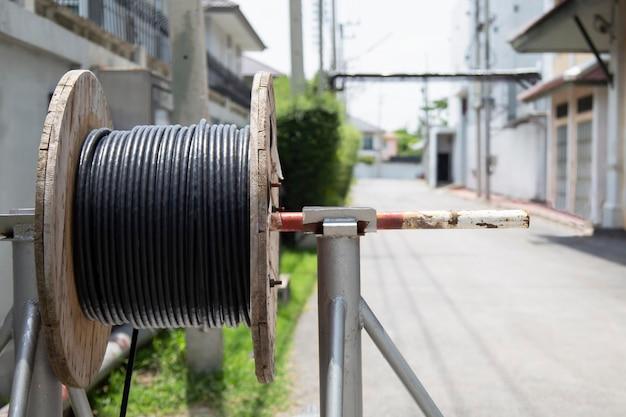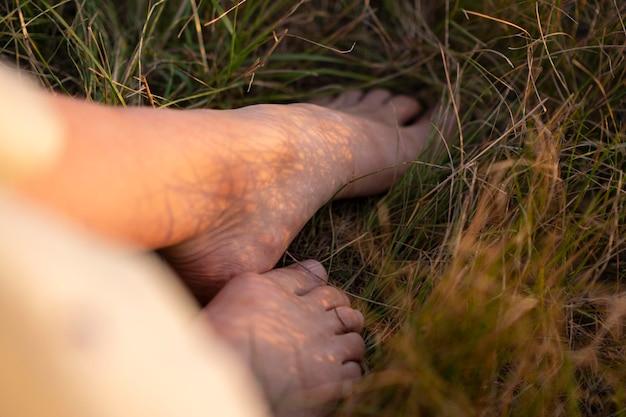Are you considering burying internet cables on your property? Maybe you’re expanding your home network or improving connectivity in your outdoor spaces. Whatever the reason, knowing the right depth for burying internet cables is crucial to ensure their protection and optimal performance. In this blog post, we’ll explore various factors to consider when burying internet cables and answer common questions like the minimum burial depth for different types of cables. So, if you’re ready to dig deeper into the world of burying internet cables, let’s get started!
One of the first questions that may come to your mind is, how deep should you bury Cat 6 cable or fiber optic cables? And what about coaxial cables? We’ll provide you with guidelines and regulations to ensure your cables are buried at an appropriate depth, whether you’re a homeowner or an installer. Additionally, we’ll cover important aspects such as the use of conduit, suitable cable types for outdoor applications, and measures to protect buried fiber optic cables. By the end of this blog post, you’ll have a comprehensive understanding of burying internet cables and the best practices to follow in 2023.
So, grab your shovels and let’s dig into the knowledge of burying internet cables at the proper depth for a reliable and efficient network!
How Deep Should Internet Cable Be Buried
When it comes to burying internet cables, you might be wondering how deep they should be buried. Well, fear not, my curious readers, for I am here to shed some light on this buried mystery!
Factors for Consideration
Several factors come into play when determining the appropriate depth for burying internet cables. One key factor is the type of cable being installed. Fiber optic cables, for instance, are fragile and require extra care. The general rule of thumb is that the cable should be buried deep enough to protect it from any potential damage caused by digging or other disturbances.
Digging Deeper: The Optimal Depth
So, what is the optimal depth we should aim for? The standard recommendation for burying internet cables is at least 18 inches. This depth helps protect the cable from accidental damage during routine gardening or landscaping activities. However, in areas with harsh winters or frequent ground freezing, it is advisable to bury the cable even deeper, around 24 to 36 inches. This prevents the cable from being affected by frost heave or being damaged by heavy-duty snow removal equipment.
Safety First: Call Before You Dig
Before you grab that shovel and start digging, make sure to call your local utility company or a specialized call-before-you-dig service. This simple step can save you a lot of headache (and potential damage to utility lines) by ensuring that you won’t accidentally disturb any existing underground infrastructure.
A Witty Digression: “A Cable’s Tale”
Once upon a time, in the vast underground realm, there lived a brave and determined internet cable named Sir Fibero the Unbreakable. Sir Fibero, along with his trusty sidekick, Copper the Reliable, ventured through the soil, overcoming obstacles like wandering tree roots and nosy moles. They journeyed to depths that would make even the burliest of earthworms quake with envy. For deep beneath the surface, they found their sanctuary, away from the dangers of human carelessness and gophers with a knack for mischief.
In conclusion, burying your internet cables at the right depth is crucial to protecting them from potential damage. The recommended minimum depth is 18 inches, but in areas prone to freezing or heavy snow removal, it is advisable to go deeper, around 24 to 36 inches. And remember, always call before you dig! So, go forth, my fellow diggers, and bury those cables with confidence, knowing that you’ve followed the depths of wisdom to keep your internet flowing smoothly in the subterranean world of connectivity!
Now, go and conquer the digging realm, my adventurous readers!
FAQ: How Deep Should Internet Cable Be Buried
Welcome to the FAQ section! Here, we’ve gathered the most frequently asked questions about burying internet cables and their depths. We hope to shed some light on this underground topic (pun intended!) and provide you with all the information you need to bury those cables with confidence.
How Deep should you Bury Cat 6 Cable
When it comes to burying your Cat 6 cable, it’s essential to adhere to the industry standards. The general rule of thumb is to bury the cable at a depth of at least 18 inches. This depth provides protection against accidental damage from future digging or gardening endeavors.
How Far can you Run Ethernet Cable from Router
The maximum length of an Ethernet cable run depends on various factors. As a general guideline, you can run an Ethernet cable up to 100 meters or approximately 328 feet from your router. Beyond this point, signal degradation may occur, leading to a less reliable connection.
How Deep does Frontier Bury Their Cable
Frontier Communications, like most providers, usually bury their cable at a depth of 24 inches. However, it’s worth noting that burying depths may differ depending on local regulations and soil conditions. Always consult with your provider or a professional for specific guidance.
What is the Code for Underground Wiring
The code for underground wiring is typically outlined in the National Electric Code (NEC). According to the NEC, underground wiring should be buried at a minimum depth of 24 inches. Following these guidelines helps protect the wiring from accidental damage and ensures compliance with safety regulations.
How Deep should a Low Voltage Cable be Buried
Low voltage cables, such as those used for internet purposes, generally require a burial depth of 6 to 12 inches. This depth provides sufficient protection while also making future maintenance or repairs more accessible.
Does Service Entrance Cable have to be in Conduit
Yes, service entrance cables are required to be in conduit. The conduit shields the cables from potential damage caused by environmental factors like moisture, UV radiation, and physical impacts. It’s a crucial protective measure to ensure the longevity and reliability of the service entrance cable.
Should Internet Cable be Buried
Absolutely! Burying your internet cable is highly recommended. Not only does it protect the cable from accidental damage caused by yard work or digging, but it also ensures a neat, organized appearance for your home or business. Plus, it minimizes the risk of tripping hazards and potential inconvenience.
How Deep are Fiber Optic Cables Buried in Feet
Fiber optic cables are typically buried at varying depths, depending on factors such as soil conditions and local regulations. However, the recommended burial depth for fiber optic cables is around 24 inches. This depth ensures protection against external elements while maintaining signal integrity.
How Deep do you Bury Schedule 80 PVC
When burying Schedule 80 PVC conduits, the recommended depth is 18 inches. This depth provides ample protection against accidental damage while maintaining easy access for future maintenance or repairs. Always consult local codes or professionals for specific requirements in your area.
Does Outdoor Wiring Need to be in Conduit
Yes, outdoor wiring should be placed inside conduit. Conduit provides an extra layer of protection against the elements, such as rain, snow, and UV radiation. It also guards against potential damage from physical impact or chewing animals, ensuring a safer and more durable outdoor wiring installation.
What Kind of Coax can be Buried
Coaxial cables designed for burial are typically labeled as “direct burial” or “outdoor rated.” These cables have additional protection, including UV-resistant coatings and durable jackets, to withstand underground conditions. Ensure you select the appropriate coaxial cable specifically manufactured for burial purposes.
Can you Use Plastic Conduit Outside
Yes, plastic conduit can be used outside, provided it is labeled for outdoor use and UV resistant. Plastic conduit offers protection for your wiring while being lightweight, easy to work with, and resistant to corrosion. Just make sure to use appropriately rated conduit suitable for outdoor installation.
Is it Safe to Run Ethernet Cable Outside
Running Ethernet cable outside is safe as long as it’s properly protected. Make sure to use Ethernet cables specifically designed for outdoor use. These cables have rugged exteriors that shield them from environmental factors like moisture, UV radiation, and temperature fluctuations, ensuring a reliable and lasting connection.
How Deep should Coax be Buried
Coaxial cables should typically be buried at a depth of 18 inches. This depth provides sufficient protection against accidental damage while allowing for easy accessibility for future maintenance or repairs.
What Electrical Cable is Suitable for Outdoor Use
For outdoor use, you should opt for electrical cables specifically marked as “outdoor” or “direct burial” cables. These cables are constructed with durable materials that resist environmental hazards and ensure safe, reliable power transmission even in extreme weather conditions.
How Deep should Residential Fiber Optic Cable be Buried
For residential fiber optic cable installations, the recommended burial depth is generally around 24 to 36 inches. This depth protects the cable from accidental damage while allowing for easy access when upgrading or performing maintenance on the fiber optic connections.
What is the Minimum Burial Depth for PVC Conduit
The minimum burial depth for PVC conduit depends on the specific requirements outlined in your local electrical code. However, as a general guideline, PVC conduit should typically be buried at a depth of at least 18 inches. Check your local code or consult a professional to ensure compliance.
How do you Protect Buried Fiber Optic Cable
To protect buried fiber optic cable, proper burial depth is crucial. Additionally, placing warning tape or markers above the buried cable helps prevent accidental damage during future excavations. It’s also essential to maintain accurate records of cable routes and adequately document any changes or additions made over time.
That wraps up our comprehensive FAQ section on burying internet cables and their depths. We hope this has been informative and entertaining, and that you feel better equipped to tackle your cable burial project. If you have any further questions, don’t hesitate to reach out to your internet service provider or consult with a professional. Happy burying, and may your internet connection always remain strong and speedy!

